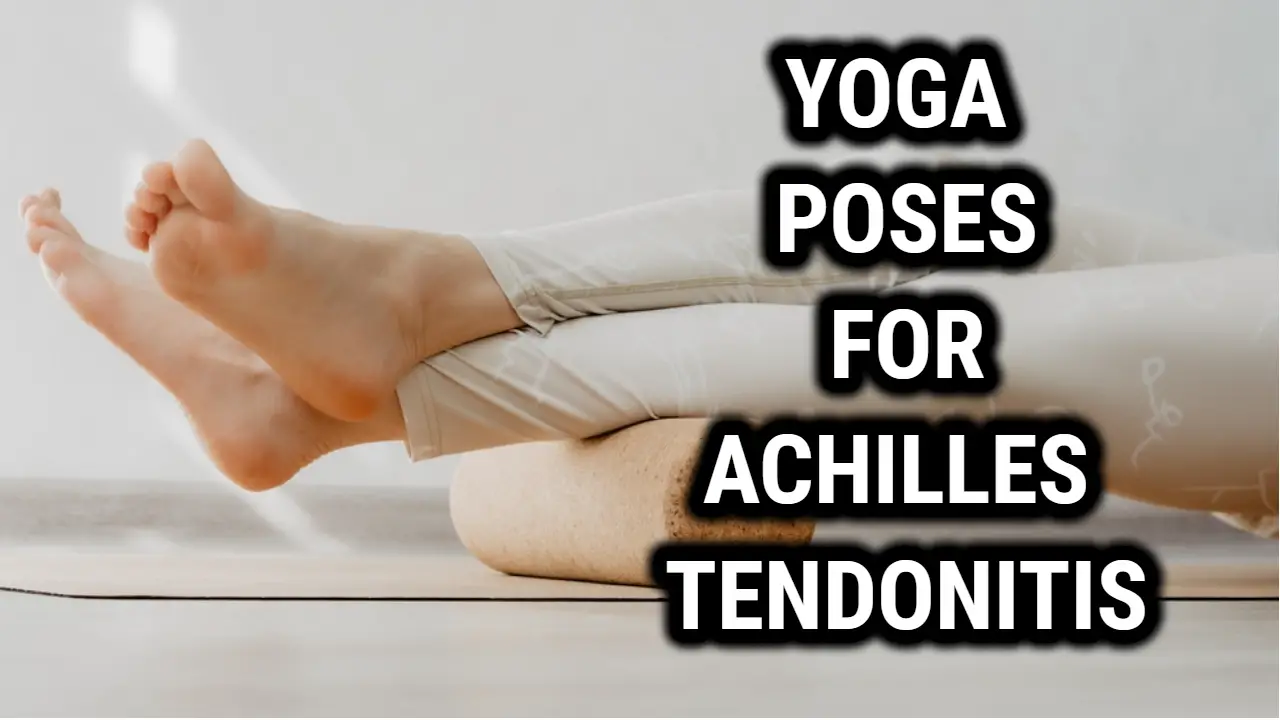Yoga for Achilles Tendonitis: Effective Poses to Alleviate Pain

Achilles Tendonitis is a common injury among athletes and fitness enthusiasts alike. It is an inflammation of the Achilles tendon, which connects the calf muscles to the heel bone. This injury can be caused by a variety of factors, including overuse, improper training, and poor footwear. Achilles Tendonitis can be a painful and debilitating condition, and it can take a long time to heal without proper treatment.
Yoga is a practice that has been around for centuries, and it has been known to provide numerous health benefits. It is a form of exercise that involves stretching, and relaxation techniques, and it has been shown to be effective in reducing pain and inflammation in the body. Yoga can be particularly helpful for those suffering from Achilles Tendonitis, as it can help to alleviate pain and promote healing.
Benefits of Yoga For Achilles Tendonitis
- Improved Flexibility: Tight muscles and tendons can contribute to or worsen the pain associated with Achilles Tendonitis. Yoga can help to improve flexibility and stretching of the calf and Achilles tendon muscles, helping to reduce the pain and improve mobility.
- Improved Balance: Balance is an important component of yoga and can help to reduce the risk of injury. Improved balance can also help to strengthen the muscles and tendons of the ankle and foot, reducing the risk of further injury or exacerbating existing Achilles Tendonitis.
- Improved Posture: Poor posture can contribute to Achilles Tendonitis. Poor posture places more stress and strain on the calf muscles and Achilles tendon, leading to pain and discomfort. Poor posture can also lead to misalignment of the feet, ankles, and lower legs, which can also contribute to Achilles Tendonitis. Yoga can help to improve posture, reducing the risk of developing Achilles Tendonitis.
- Stress Reduction: Stress can contribute to the development of Achilles Tendonitis. Stress can cause the muscles and tendons of the ankle and foot to become tense and stressed, leading to pain and inflammation. Yoga can help to reduce stress and relax the body, helping to lessen the pain associated with Achilles Tendonitis.
Understanding Achilles Tendonitis: Causes and Symptoms
Achilles Tendonitis is a common condition that affects the Achilles tendon, which is the largest tendon in the body. This tendon connects the calf muscles to the heel bone and is responsible for supporting the foot during activities like walking, running, and jumping.
Achilles Tendonitis is an overuse injury that is caused by repetitive stress and strain on the tendon. In this article, we will explore the causes, symptoms, and diagnosis of Achilles Tendonitis.
Causes of Achilles Tendonitis
Achilles Tendonitis is typically caused by overuse or repetitive stress on the Achilles tendon. This can be due to a variety of factors, including:
- Intense physical activity, such as running or jumping, especially if done on hard surfaces
- Tight calf muscles or a lack of flexibility in the ankle joint
- Improper footwear, such as shoes that do not provide adequate support
- Sudden increase in activity level, such as a new exercise routine or training program
- Age-related degeneration of the tendon
Symptoms of Achilles Tendonitis
The most common symptom of Achilles Tendonitis is pain and stiffness in the back of the heel or lower calf. This pain may be mild to severe and can be exacerbated by physical activity. Other symptoms may include:
- Swelling or tenderness in the affected area
- Difficulty walking or running due to pain and stiffness
- A popping or snapping sound when the tendon is moved
- Limited range of motion in the ankle joint
How Yoga Can Help Relieve Pain and Improve Function
Achilles Tendonitis is a painful and often debilitating condition that affects the Achilles tendon, which connects the calf muscles to the heel bone. While rest, physical therapy, and pain management techniques are often used to treat Achilles Tendonitis, many people have found relief through practicing yoga.
Stretching and Strengthening the Affected Muscles and Tendons
One of the primary benefits of yoga for those with Achilles Tendonitis is the ability to stretch and strengthen the affected muscles and tendons. Many yoga poses focus on the calf muscles and the muscles around the ankle joint, which can help to increase flexibility and range of motion while also building strength in these areas.
Some of the most beneficial yoga poses for those with Achilles Tendonitis include:
- Downward-Facing Dog: This pose stretches the calves and hamstrings while also strengthening the arms and shoulders. Begin on your hands and knees, then lift your hips up and back, bringing your body into an upside-down “V” shape.
- Warrior II: This pose strengthens the legs and opens up the hips while also stretching the calves. Begin standing with your feet hip-width apart, then step one foot back and turn it out at a 90-degree angle. Bend the front knee and extend the arms out to the sides.
- Half Pigeon Pose: This pose stretches the glutes and hips while also gently stretching the calf muscles. Begin on your hands and knees, then bring one knee up and place it behind your hand. Slide the other leg back and straighten it out behind you.
Focus on Alignment and Stability
In addition to stretching and strengthening the affected muscles and tendons, yoga can also help to improve alignment and stability in the ankle joint. Many yoga poses require balance and stability, which can help to strengthen the muscles and tendons that support the ankle.
Focusing on proper alignment can also help to reduce the risk of further injury or aggravation of the Achilles tendon. Some yoga poses that can help to improve alignment and stability include:
- Tree Pose: This pose challenges your balance and strengthens the muscles in the feet and ankles. Begin standing with your feet hip-width apart, then shift your weight onto one foot and bring the other foot up to rest on the inner thigh of the standing leg.
- Eagle Pose: This pose stretches the calves and strengthens the muscles around the ankle joint. Begin standing with your feet hip-width apart, then cross one leg over the other and bring the arms up to cross at the elbows.
- Warrior III: This pose strengthens the muscles in the legs and hips while also improving balance and stability. Begin standing with your feet hip-width apart, then hinge forward at the hips and lift one leg up behind you while extending the arms out in front of you.
Precautions and Tips for Practicing Yoga with Achilles Tendonitis
- Consult with a Healthcare Professional Before beginning any new exercise program, it’s important to consult with a healthcare professional, particularly if you are experiencing pain or discomfort in the affected area. Your healthcare professional can help you to determine which types of yoga poses and movements are safe for you to practice with Achilles Tendonitis, and may also provide you with some specific exercises or stretches to help alleviate your symptoms.
- Listen to Your Body When practicing yoga with Achilles Tendonitis, it’s important to listen to your body and be mindful of any pain or discomfort you may be experiencing. If a particular pose or movement is causing pain or discomfort in the affected area, modify or avoid the pose altogether. Instead, focus on poses and movements that feel comfortable and don’t exacerbate your symptoms.
- Warm-Up Properly Before beginning your yoga practice, it’s important to properly warm up your muscles and tendons. This can help to increase blood flow to the affected area, reduce tension in the muscles, and prepare your body for the movements and poses to come. A proper warm-up might include some gentle stretching, light cardio exercises, or even a short meditation or breathing exercise.
- Modify Your Poses When practicing yoga with Achilles Tendonitis, it’s important to modify your poses to avoid putting excessive strain on the affected area. For example, instead of practicing a deep lunge that stretches the Achilles tendon, you might modify the pose to a gentle lunge that doesn’t put as much pressure on the affected area. Your yoga instructor can help you to modify poses as needed to ensure that you are practicing safely.
- Avoid High Impact Movements High impact movements, such as jumping or running, can exacerbate the symptoms of Achilles Tendonitis. When practicing yoga with Achilles Tendonitis, it’s important to avoid high impact movements and instead focus on low impact movements and poses that don’t put as much strain on the affected area. For example, instead of practicing a jumping forward fold, you might modify the pose to a gentle forward fold that doesn’t put as much pressure on the affected area.
- Use Props Props, such as blocks, blankets, or straps, can be helpful when practicing yoga with Achilles Tendonitis. Props can help to provide support and stability, allowing you to practice poses safely and without exacerbating your symptoms. For example, a block can be used to support your hands in a forward fold, reducing the strain on your Achilles tendon.
FAQ’s
Q. Can I still practice yoga if I have Achilles Tendonitis?
A. Yes, you can still practice yoga if you have Achilles Tendonitis, but it’s important to approach your practice mindfully and take certain precautions to avoid exacerbating the injury. Consult with a healthcare professional and modify your poses as needed to avoid putting excessive strain on the affected area.
Q. Can yoga cure Achilles Tendonitis?
A. While yoga may not cure Achilles Tendonitis, it can be a helpful way to alleviate the symptoms and support the healing process. It’s important to work with a healthcare professional and follow a comprehensive treatment plan that may include yoga, stretching, and other exercises.
Q. What poses should I avoid when practicing yoga with Achilles Tendonitis?
A. You may want to avoid poses that put excessive strain on the Achilles tendon, such as deep lunges, jumping poses, or standing poses that require balancing on the affected foot. Your yoga instructor can help you to modify poses as needed to ensure that you are practicing safely.
Q. Can props be helpful when practicing yoga with Achilles Tendonitis?
A. Yes, props such as blocks, blankets, or straps can be helpful when practicing yoga with Achilles Tendonitis. Props can help to provide support and stability, allowing you to practice poses safely and without exacerbating your symptoms.
Q. How can I warm up properly before practicing yoga with Achilles Tendonitis?
A. A proper warm-up may include some gentle stretching, light cardio exercises, or even a short meditation or breathing exercise. The goal is to increase blood flow to the affected area, reduce tension in the muscles, and prepare your body for the movements and poses to come. Your healthcare professional or yoga instructor can provide specific warm-up exercises that are safe for your condition.
Final Words
Incorporating yoga into your routine can be a helpful way to alleviate the symptoms of Achilles Tendonitis. However, it’s important to approach your practice mindfully, taking into account your body’s limitations and modifying poses as needed to avoid exacerbating the injury.
By following these precautions and tips, you can safely and effectively practice yoga with Achilles Tendonitis and support your body’s healing process.






